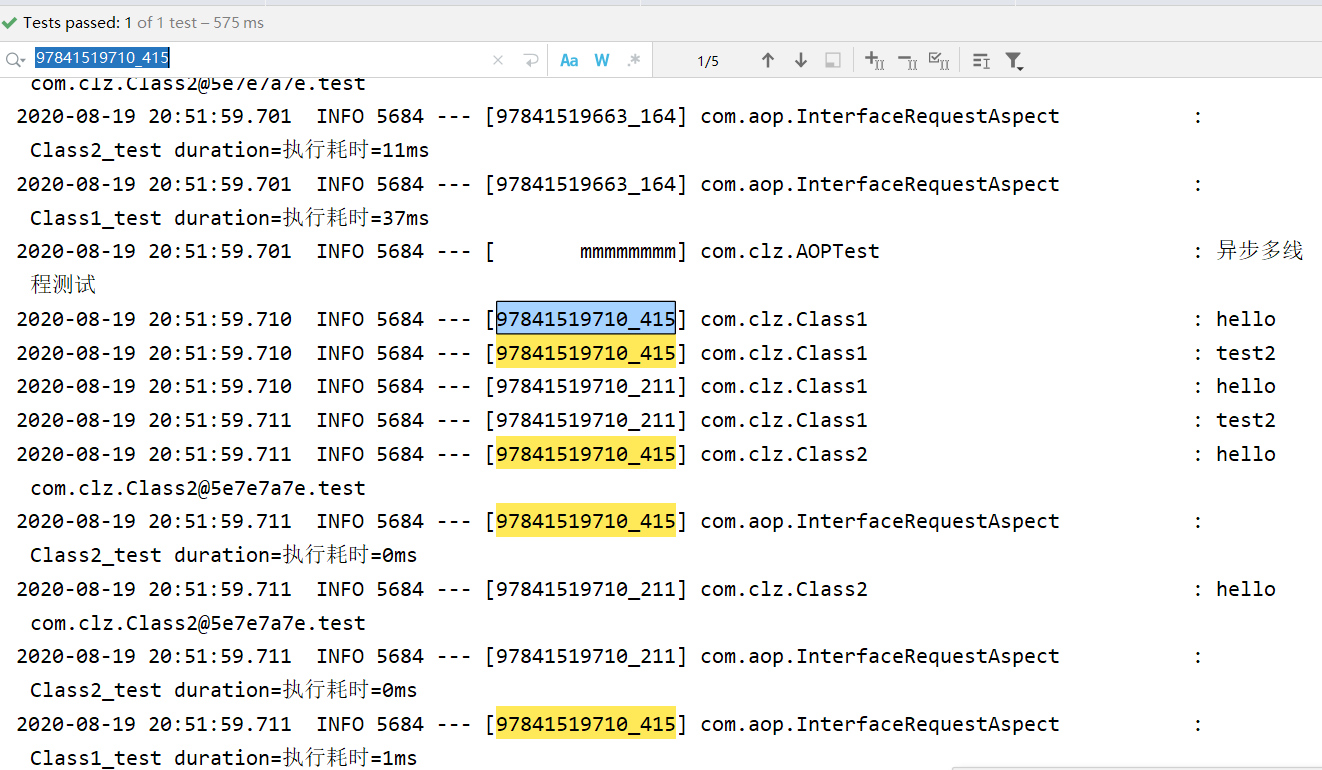如何快速过滤出一次请求的所有日志?
之前在.net项目和java项目里有过不同的最佳实践。见下面链接。
▄︻┻┳═一巧用CurrentThread.Name来唯一标记一次请求的所有日志
▄︻┻┳═一巧用CurrentThread.Name来唯一标记一次请求的所有日志(续)
▄︻┻┳═一巧用CurrentThread.Name来唯一标记一次请求的所有日志(完结篇)
▄︻┻┳═一asp.net拦截器
▄︻┻┳═一巧用CurrentThread.Name来唯一标记一次请求的所有日志(java-logback篇)
本文呢,还是java项目,这次用AOP来实现。
至于为什么要改threadName,为什么要用AOP,就不再铺垫赘述了。Talk is cheap, show me the code。下面代码可以直接使用,拿走不谢。
package com.aop; import lombok.extern.slf4j.Slf4j; import org.aspectj.lang.JoinPoint; import org.aspectj.lang.ProceedingJoinPoint; import org.aspectj.lang.annotation.After; import org.aspectj.lang.annotation.Around; import org.aspectj.lang.annotation.Aspect; import org.aspectj.lang.annotation.Pointcut; import org.springframework.stereotype.Component; import java.util.Random; /** * 重置工作线程名为唯一字符串, * 这样在生产排障时,可以快速过滤一次请求的所有日志 */ @Slf4j @Component @Aspect public class WorkThreadNameAspect { @Pointcut("execution(public * com.clz.*.*(..))") public void pointCut() { } ThreadLocal<String> threadLocal = new ThreadLocal<>(); // @Before("pointCut()") // public void before(JoinPoint joinPoint) { public void setThreadName(JoinPoint joinPoint) { // if (Thread.currentThread().getName().contains("-")) { String threadNameFlag = getMethodSignature(joinPoint); String before = Thread.currentThread().getName(); String s = threadLocal.get(); if (threadLocal.get() == null) { String threadName = threadNameFlag + System.currentTimeMillis() + "_" + new Random().nextInt(1000); threadLocal.set(threadName); Thread.currentThread().setName(threadName); } log.debug("threadName={}→→→{}, threadLocal.get()={}→→→{}", before, Thread.currentThread().getName(), s, threadLocal.get()); // } } String getMethodSignature(JoinPoint joinPoint) { return joinPoint.getSignature().getDeclaringType().getSimpleName() + "_" + joinPoint.getSignature().getName(); } @After("pointCut()") public void after(JoinPoint joinPoint) { String threadNameFlag = getMethodSignature(joinPoint); if (threadLocal.get() != null && threadLocal.get().contains(threadNameFlag)) { log.debug("remove name {}", Thread.currentThread().getName()); threadLocal.remove(); } } @Around("pointCut()") public Object around(ProceedingJoinPoint joinPoint) throws Throwable { setThreadName(joinPoint); long start = System.currentTimeMillis(); try { return joinPoint.proceed(joinPoint.getArgs()); } finally { log.info("{} duration=执行耗时={}ms", getMethodSignature(joinPoint), System.currentTimeMillis() - start); } } }
注意,aspectj里各个advice的执行顺序,Around advice是先于Before advice的,所以设置线程名要在@Around注解的方法里来执行。下图是advice的执行顺序。

好了。如下多线程模拟并发来测试,从运行结果可以看出,想定位某一次请求的日志,就方便多了。
package com.clz; import lombok.extern.slf4j.Slf4j; import org.junit.jupiter.api.Test; import org.junit.runner.RunWith;import org.springframework.boot.test.context.SpringBootTest; import org.springframework.test.context.junit4.SpringRunner; import java.util.concurrent.LinkedBlockingDeque; import java.util.concurrent.ThreadPoolExecutor; import java.util.concurrent.TimeUnit; @Slf4j @SpringBootTest @RunWith(SpringRunner.class) class AOPTest { @Autowired private Class1 class1; @Test public void testWorkThreadName() throws InterruptedException { class1.test(); Thread.currentThread().setName("mmmmmmmm"); log.info("异步多线程测试"); ThreadPoolExecutor poolExecutor = new ThreadPoolExecutor(5, 5, 10, TimeUnit.MILLISECONDS, new LinkedBlockingDeque<>(5)); Thread.sleep(5); for (int i = 0; i < 2; i++) { poolExecutor.execute(() -> { class1.test(); // csdfsdafdsfdsfdsf.test(); }); } poolExecutor.shutdown(); poolExecutor.awaitTermination(2, TimeUnit.SECONDS); } }
如下是执行结果。
当我们在linux服务器上定位log时,实现了slf4j-api的日志框架,不管是log4j/log4j2,还是logback,只要每条日志的前缀携带线程名(默认是有的,见pattern标识符%t或%thread),直接grep某次请求的唯一线程名,就可以看到程序处理本次请求的所有日志了。
如果没有这个切面来reset线程名,因为线程池的线程是可复用的,多次请求的工作线程可能是一个。那么,按线程名去grep日志的话,得到的可就不止于某一次请求的了,这对于高频访问的系统的排障,会带来诸多不便,甚至会导致误判。
